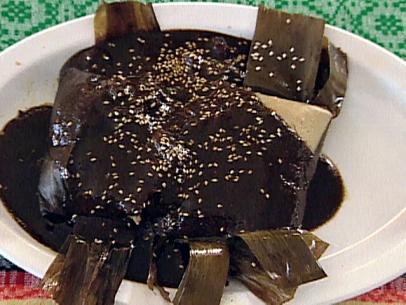
Mole Negro
- Level: Intermediate
- Total: 3 hr 30 min
- Active: 3 hr 30 min
- Yield: 8 to 10 cups
- Level: Intermediate
- Total: 3 hr 30 min
- Active: 3 hr 30 min
- Yield: 8 to 10 cups
Ingredients
Directions
- Working in batches, place the pasilla, chilhuacle and mulato chiles on a comal or large cast-iron skillet over medium-low heat, making sure you don’t crowd the pan. Heat the chiles until they develop a deep-red hue and then turn chocolate brown, about 10 minutes, flipping them halfway through; they will develop a smoky flavor but be sure not to burn them. Place the chiles in a large bowl and cover them with warm water; drain and change the water twice. Set them aside to soak for at least 15 minutes and no more than 30 minutes. Drain the chiles and reserve 2 cups of the soaking water.
- Wipe out the comal or skillet with a dry towel. Place the almonds, peanuts, pepitas and walnuts in the skillet and place it over medium heat. Toast the nuts, stirring or shaking the pan frequently, until some char marks begin to appear, 6 to 8 minutes. Remove from the skillet and set aside.
- Wipe out the comal again and add the sesame seeds, anise seeds, coriander seeds, peppercorns, allspice, cumin seeds, cloves, cinnamon stick and avocado leaves. Place the skillet over medium-low heat and toast the spices until aromatic, moving them frequently so that they don’t burn, 3 to 4 minutes. Set these aside.
- Make sure you have good ventilation for the next step. Add the reserved chile seeds and veins to the skillet and place it over medium-low heat. Toast the seeds until they are black and shiny, 5 to 8 minutes, moving them frequently so they don’t stick to the pan. Turn off the heat, move all the seeds into a small mound on one side of the pan, then use a stick lighter or culinary torch to carefully light the seeds on fire; this should produce a small, low flame. Wait until the flame dies down and the seeds begin to smoke, 30 to 40 seconds. Cover them with a metal bowl to contain the smoke and extinguish the flame. If you can, place the skillet outside. Wait at least 5 minutes, then remove the bowl, handling it carefully as it may be hot. Make sure the seeds are no longer shiny, they should be matte black, if not light them again.
- Preheat the broiler. Place the tomatillos, tomatoes, onion and garlic on a small baking sheet. Broil the vegetables, flipping them halfway through, until they are blistered, softened and char marks develop, 8 to 10 minutes. (This step can also be done in a skillet on the stovetop if you don’t have a broiler.) Set the vegetables aside.
- Over a medium-low open flame, use tongs to hold the tortillas one at a time over the flame and char them, flipping halfway, 2 to 3 minutes. Set them aside in a metal bowl.
- Place the roll in a small skillet and toast it on all sides over medium heat until some deep char marks appear, 3 to 4 minutes. Set aside.
- Heat 1 tablespoon manteca or neutral oil in the same small skillet over medium heat. Add the raisins and prunes and cook, stirring them constantly so that they don’t burn, until the raisins have softened and plumped, 2 to 3 minutes. Remove from the skillet and set aside.
- Add the plantain slices to the same small skillet along with 1 tablespoon of the manteca if necessary. Cook the plantain until charred and softened, 6 to 8 minutes, flipping halfway through, and set it aside.
- Use a spice grinder to grind the toasted nuts, pepitas and toasted spices (but not the avocado leaves) until finely ground but not until they make a paste, 30 to 40 seconds. Set aside.
- Grind the toasted chile seeds in the spice grinder until they look like ash, 15 to 20 seconds. Set these aside in a separate bowl from the ground up nuts and spices.
- Combine the chiles and all the toasted ingredients except for the avocado leaves. Working in 3 to 4 batches, place the ingredients in a high-powered blender, adding enough of the reserved chile soaking water so each batch blends smoothly, about 1/4 cup. Blend each batch until you have a smooth paste, 2 to 3 minutes. Place a mesh strainer over a large bowl and strain each batch. The paste should easily passed through, but if large pieces remain blend them again with additional chile soaking water or chicken broth.
- Heat 3 tablespoons of manteca in a large Dutch oven set over medium-high heat until smoking. Add the strained sauce, bring to a simmer stirring constantly with a wooden spoon. The sauce will begin to bubble and sputter, just keep stirring; this step will darken and emulsify all the ingredients. Continue cooking, stirring frequently to prevent the sauce from sticking to the bottom of the pan, until the sauce has thickened slightly, 15 to 20 minutes.
- Once the sauce has thickened slightly, lower the heat to medium low. Add the thyme, marjoram and oregano to the pot, first rubbing each between your fingers to crush them and release their flavor. Add the broth, avocado leaves and chocolate to the pot. Season with salt to taste. Let the mole reduce and cook until it thickens, stirring often so that the mole does not burn and stick to the pot. It should cook for at least 40 minutes so that the flavors can develop, but it can continue to cook for up to 2 hours. The longer it cooks, the more developed the flavors will become and the thicker it will be.
- If your mole thickens up too much stir in more broth. Serve the mole on top of poached chicken or any other protein or in enchiladas. Garnish with toasted sesame seeds.
Cook’s Note
To easily deseed the chiles, use kitchen shears or a paring knife to remove the stem, then split the chiles open lengthwise. With your fingers, gently scrape out the seeds and veins. Use gloves to protect your hands from the chiles’ stinging oils. Chilhuacle is a chile native to Oaxaca but often hard to find elsewhere. A good substitute for it is a combination of more pasilla negro chiles and some cascabel chiles. It’s important to have proper ventilation to char the chiles (and particularly the seeds) as they can produce strong fumes. If possible, do the step of burning the seeds on fire outdoors. Mole can be refrigerated in an airtight container for 3 to 4 days or frozen for 3 to 4 months.
































